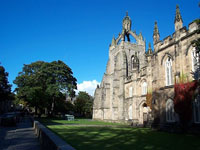 Aberdeen OverviewThe bustling seaport of Aberdeen is Scotland's third biggest
city, and has been dubbed the Oil Capital of Europe. This alone is
not likely to entice visitors to the city, other than those on
business trips, but the fact that Aberdeen boasts a fascinating and
bloody history, historic granite buildings, beautiful churches,
attractive green spaces and plenty of Scotch whisky, just
might. Once a site of brutal conflict with the English during the
Scottish Wars of Independence, the city was razed to the ground by
King Edward III in 1336, but was quickly rebuilt and expanded
rapidly over the centuries as it grew in prominence as a port. The
18th and 19th centuries saw an increase in elegance and style in
the city, predominantly in the architecture of Old Aberdeen, an
area of buildings made from the glittering local granite. Here,
architectural gems include the 15th-century Kings College, the Town
House, and Marischal College, one of the best examples of Edwardian
architecture in Britain. Modern Aberdeen is friendly and fun, although foreigners may
struggle to understand the thick local accent. Belmont Street and
surrounds are packed with restaurants, clubs, bars and live music
venues; there are plenty of top-class museums and galleries
including the Maritime Museum and the Aberdeen Art Gallery; and the
city boasts a host of lush parks, including Duthie Park, which
opened in 1883. The vibrant waterfront district also merits
exploration, as well as some of the lovely sandy beaches close
by. Aberdeen also acts as a perfect hub from which to explore the
beauty and majesty of the Grampian Highlands, enjoy a tipple on the
Malt Whisky trail or ramble around ancient Scottish castles. |